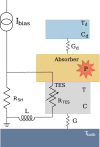The matrix optimum filter for low temperature detectors dead-time reduction
- PMID: 35572034
- PMCID: PMC9090876
- DOI: 10.1140/epjc/s10052-022-10379-w
The matrix optimum filter for low temperature detectors dead-time reduction
Abstract
Experiments aiming at high sensitivities usually demand for a very high statistics in order to reach more precise measurements. However, for those exploiting Low Temperature Detectors (LTDs), a high source activity may represent a drawback, if the events rate becomes comparable with the detector characteristic temporal response. Indeed, since commonly used optimum filtering approaches can only process LTDs signals well isolated in time, a non-negligible part of the recorded experimental data-set is discarded and hence constitute the dead-time. In the presented study we demonstrate that, thanks to the matrix optimum filtering approach, the dead-time of an experiment exploiting LTDs can be strongly reduced.
© The Author(s) 2022.
Figures








References
-
- N.E. Booth, B. Cabrera, E. Fiorini, Annu. Rev. Nucl. Part. Sci. 46e (1996). 10.1146/annurev.nucl.46.1.471
-
- E. Gatti, P. Manfredi, Riv. Nuovo Cim. 9N1 (1986). 10.1007/BF02822156
-
- Fowler JW, et al. Am. Astron. Soc. 2015 doi: 10.1088/0067-0049/219/2/35. - DOI
-
- K. Irwin, G. Hilton, Cryog. Part. Det. 99 (2005). 10.1007/10933596_3
LinkOut - more resources
Full Text Sources
